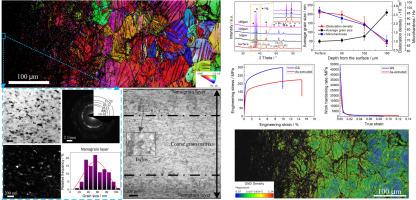Deformation behavior and strengthening mechanism of a gradient nanostructured WE43 Mg alloy
IF 13.8
1区 材料科学
Q1 METALLURGY & METALLURGICAL ENGINEERING
引用次数: 0
Abstract
A gradient nanostructured WE43 Mg alloy with a top layer grain size of approximately 50 nm was fabricated using sliding friction technique (SFT). The formation mechanism of this gradient nanostructure (GS), the deformation mode and the strengthening effect were investigated in detail using TEM, EBSD and XRD. The results showed that microstructure evolution primarily underwent three stage to form the GS. In the early stage, deformation was dominated by a combination of multiple slip systems and twinning. In the intermediate stage, twins and coarse grains broke down into fine lath structures and smaller grains due to dislocation pile-ups and stacking faults (SFs). In the final stage, these fine grains were further refined into nanograins with the help of SFs. Compared with the original alloy, the introduced GS significantly enhanced the mechanical properties, and had a good work hardening capabilities. The strengthening mechanisms are primarily attributed to dislocation strengthening and grain boundary strengthening. This study offers valuable insights for the development of Mg alloy, aimed at enhancing performance and optimizing microstructure in engineering applications.

梯度纳米结构WE43镁合金的变形行为及强化机理
采用滑动摩擦技术(SFT)制备了一种顶层晶粒尺寸约为50 nm的梯度纳米WE43镁合金。利用透射电镜(TEM)、电子衍射衍射仪(EBSD)和x射线衍射仪(XRD)对该梯度纳米结构(GS)的形成机理、变形方式和强化效果进行了详细研究。结果表明:GS的形成主要经历了三个阶段的微观组织演化。早期变形以多滑系和孪晶组合为主。在中间阶段,孪晶和粗晶由于位错堆积和层错(SFs)而分解成细板条组织和小晶粒。在最后阶段,这些细小的颗粒在SFs的帮助下进一步细化为纳米颗粒。与原合金相比,引入的GS合金的力学性能显著提高,并具有良好的加工硬化能力。强化机制主要是位错强化和晶界强化。该研究为镁合金的发展提供了有价值的见解,旨在提高镁合金的性能和优化其在工程应用中的组织。
本文章由计算机程序翻译,如有差异,请以英文原文为准。
求助全文
约1分钟内获得全文
求助全文
来源期刊

Journal of Magnesium and Alloys
Engineering-Mechanics of Materials
CiteScore
20.20
自引率
14.80%
发文量
52
审稿时长
59 days
期刊介绍:
The Journal of Magnesium and Alloys serves as a global platform for both theoretical and experimental studies in magnesium science and engineering. It welcomes submissions investigating various scientific and engineering factors impacting the metallurgy, processing, microstructure, properties, and applications of magnesium and alloys. The journal covers all aspects of magnesium and alloy research, including raw materials, alloy casting, extrusion and deformation, corrosion and surface treatment, joining and machining, simulation and modeling, microstructure evolution and mechanical properties, new alloy development, magnesium-based composites, bio-materials and energy materials, applications, and recycling.
 求助内容:
求助内容: 应助结果提醒方式:
应助结果提醒方式:


